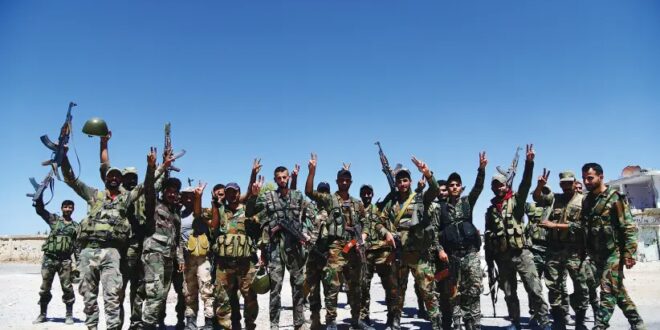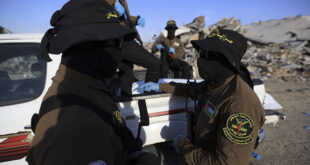BEHIND THE LINES: In the southwest, the outside powers of relevance are Iran and Russia. The arrangement in place from July 2018 until now was the product of an uneasy standoff between them.
In a new ceasefire agreement that may bring an end to a 75-day Assad-regime siege on the Syrian town of Deraa al-Balad, Syrian rebels have, with few alternatives, made far-reaching concessions to the Syrian government. The siege and the subsequent agreement bring an end to an anomalous situation that had pertained in Deraa al-Balad since the area’s reconquest by regime, Russian and Iranian forces in July 2018.
Since that time, Russia had underwritten a situation in which former rebels were able to hold light weapons and maintain security inside the town. The regime, meanwhile, did not attempt to establish checkpoints or impose its rule in Deraa al-Balad.
The regime offensive under way since June was intended to terminate this situation and reimpose direct rule, as part of President Bashar Assad’s effort to reconquer all parts of Syria currently outside of government control. In Deraa al-Balad, this objective now looks well on the way to being achieved. The siege has been brutal, in the usual Assad manner. Food and medical supplies have been kept out of the area, in which around 50,000 people are resident. Electricity supplies, patchy even before the siege, were cut off.
The shifting balance of power in this southwestern Syrian province matters to Israel, because Deraa province borders the Golan Heights. It is the location of an Iranian strategic project to establish and deploy forces under its control in the area, with the intention that these may be used in a future clash between Jerusalem and Tehran, or Iran’s local proxy, Hezbollah.
Iran controls the border crossing at Abu Kamal, further east, linking Syria to Iraq. The Iranians have freedom of movement across the south of the country. They have built a number of facilities close to the border crossing, including the large Imam Ali base.
From Israel’s point of view, the main obstacle to the consolidation and entrenchment of this Iranian project, other than Israel’s own military actions, has been the Russian presence in the area. The Russians do not support the Iranian project to build a capacity for aggression against Israel in southwestern Syria. Their own project of limited cooperation with former rebels appeared indeed to be pushing in the other direction.
The apparent Russian shift toward acquiescence to Iranian desires reflected in the Deraa agreement will thus not be welcomed in Jerusalem. Going together with increasing signs of Russian impatience with Israel’s air campaign against Iranian targets in Syria, it is an indication that any Israeli hopes that Russia might play a role in limiting Iran’s influence in Syria may have to be revised.
At present, around 30% of Syria remains outside regime control. The main areas outside Damascus’s remit in Syria are currently invulnerable to incursions because they are guaranteed by external powers. These are the Kurdish-dominated Autonomous Authority of North and East Syria (AANES) – whose continued existence is currently underwritten by the presence of US forces on its soil, and the Turkish-occupied area in Syria’s northwest.
In the southwest, the outside powers of relevance are Iran and Russia. The arrangement in place from July 2018 until now was the product of an uneasy standoff between them.
Moscow chose to align itself with former rebel commander Ahmed Oda and his comrades. These were re-mustered as the 8th Brigade of the 5th Corps of the Syrian Army, a Russian-created structure. The 8th Brigade was for a time directly under Russian command. Russian officers played a role in it at various levels.
The recent regime offensive constituted a direct Iranian attempt to challenge this Russian project head on. The offensive was spearheaded by the 4th Division. This formation is often described as one of the Assad regime’s “Praetorian” units. It is majority Alawite in composition and is staffed by professional soldiers, rather than conscripts. Commanded de facto by Maher Assad, the president’s brother, the 4th Division today works closely with the Islamic Revolutionary Guard Corps and is a key component of Iran’s efforts to blur the distinction between “regime” forces and Iranian proxies. Air Force Intelligence and the Republican Guard are additional elements working closely with Tehran.
The 4th Division’s offensive against Deraa al-Balad, beginning in late June, progressed slowly. Indeed, it is testimony to the very limited capacities of this supposedly “elite” division that it has taken it more than two months to pacify an area controlled by (albeit experienced) fighters armed only with light weapons.
The key aspect in Deraa al-Balad’s surrender was the Russian decision to abandon ambiguity and make clear that it would support further regime action against the area if the former rebel fighters did not agree to regime demands.
As of now, the former rebels have agreed to terms in the Russian-mediated negotiations, which represent their complete surrender to the demands of the regime. The agreement, according to reporting from the Syrian Observatory for Human Rights, will see the establishment of 10 security points and checkpoints inside Deraa al-Balad, under Russian military police supervision, where the Russian flag and the Syrian regime flag will be raised. In addition, individuals wanted for mandatory military service will need to “regularize” their situation with the regime. All individuals wishing not to conform to these terms will have to depart for the Turkish and Islamist-rebel controlled area in the northwest.
Abdullah Al-Jabbassini, a Syrian researcher who monitors the southwest, noted in addition that the agreement will include the surrender of light weapons by the fighters in Deraa al-Balad. Jabbassini also recorded that according to the agreement, Russian military police will be involved in direct contact with the community, including checking identification cards at checkpoints, and that local notables will accompany the security forces.
These two latter elements are clearly intended to soften the blow for the former rebels, and to reduce as far as possible the friction that would result from direct contact between them and Assad’s security forces. But what has taken place is a significant achievement for the Iran-aligned element within the official Syrian security forces. It also represents an abandonment by the Russians of the stance they sought to maintain since July 2018 – namely, the effort to maintain the status quo established by the reconciliation agreement of that time.
Why has this happened now? Tensions in this area are not new and have smoldered ever since the regime’s return in 2018. But the latest events reflect growing Iranian confidence, which itself appears to derive from a fading Russian commitment to the status quo. The latter element is the crucial point, creating the space for change, which the most Iran-aligned element of the regime has now exploited.
The reason for this apparent shift in Russia’s position is less clear, but the direction appears unmistakable. It may well be that the sense of an American weakening in the region also contributes to Iranian boldness, and Russian disregard of the concerns of local US allies. The result will be the further advance of the Iranian interest in southwestern Syria. This interest is woven into the decrepit structures of the Assad regime. It represents ambitions, strategy and priorities determined in Tehran, not in Damascus. And it is currently extending all the way to the border with Israel.
 Eurasia Press & News
Eurasia Press & News




